Anyone who loves good food knows that France is home to one of the greatest cuisines in the world. With its formal techniques, complex sauces, and exquisite presentation of dishes, no other cuisine has been more influential than French cuisine. If you’ve ever enjoyed a croissant from a pastry shop in your home country, then you’ve experienced this influence first-hand.
French pastry chefs have produced some of the world’s best pastries, cakes, and desserts. The croissant is the most famous example but visit any pastry shop in France and you’ll find a wealth of delectable confections to swoon over.
If you’re planning a trip to Paris and have a taste for the sweeter things in life, then this list of the best French pastries will tell you exactly what you need to look for.
FRENCH PASTRY QUICK LINKS
If you’re planning a trip to France and want to really dive into the cuisine, then you may be interested in going on a food tour or taking a cooking class.
TOURS & OTHER SERVICES
- Food Tours: Food and Wine/Drinking Tours in France
- Cooking Classes: Cooking Classes in France
- eSIM: France eSIM
Save This on Pinterest!
No time to read this article on traditional French pastries? Click on the save button and pin it for later!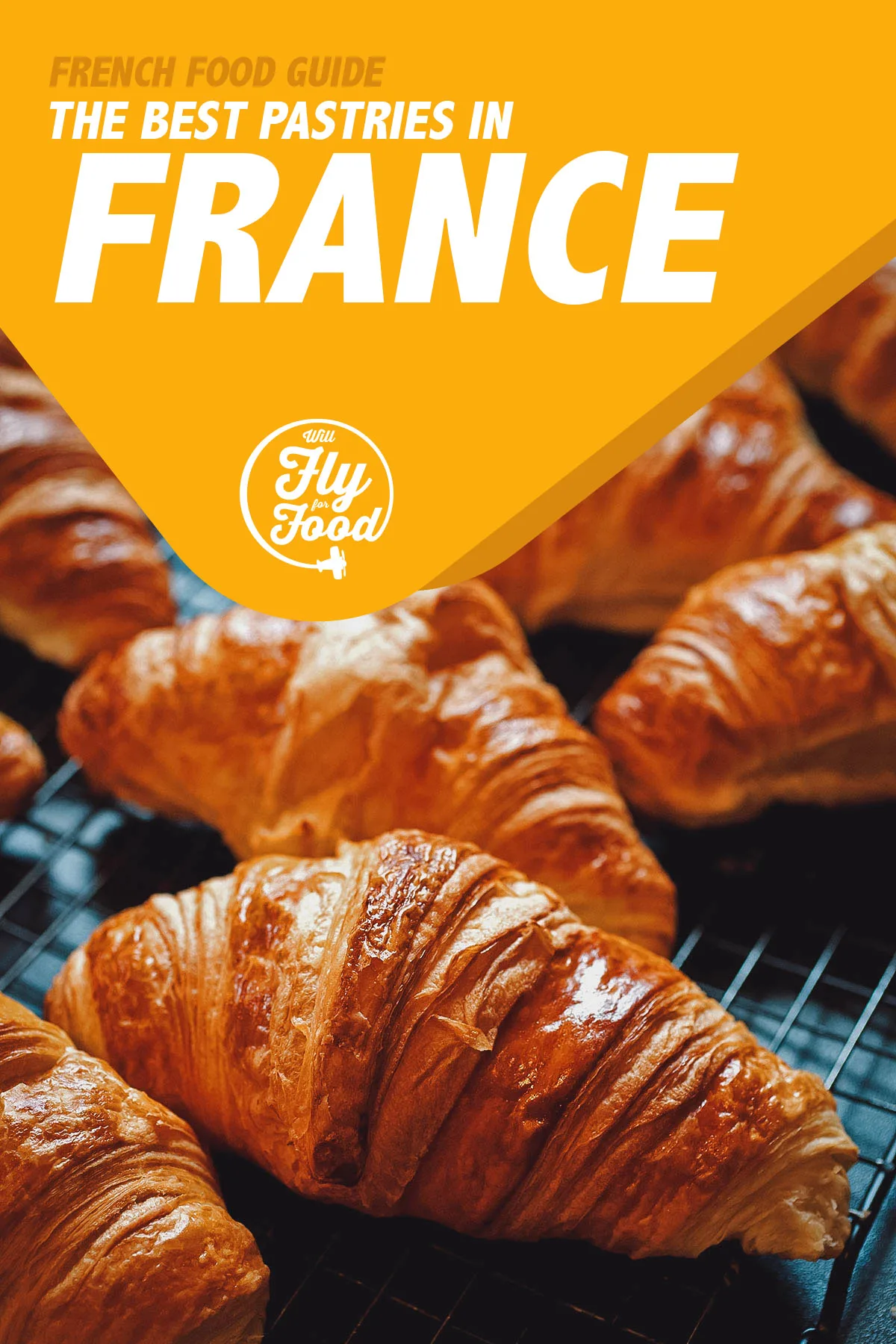
Photo by Fotosmurf
THE BEST FRENCH PASTRIES
1. Croissant
There’s no better way to start this article on the best French pastries than with the iconic croissant. This buttery, flaky pastry is the most popular French pastry and beloved by many breakfast lovers from around the world.
Named for its crescent shape, the croissant is made with a laminated yeast-leavened dough. The dough is layered with butter, rolled, and folded several times before being rolled into a thin sheet. The dough is cut into triangles and then folded into the familiar crescent shape before baking.
While baking, the water in the butter vaporizes and expands, causing the dough to puff up and separate. The fat in the butter essentially fries the dough which results in a light, layered, and flaky pastry similar to a puff pastry.
Interestingly, the croissant is associated with France but it’s actually Austrian in origin. It’s a type of viennoiserie pastry (meaning “things of Vienna”) derived from the kipferl – an Austrian crescent-shaped bread roll. A Viennese bakery became popular in Paris in the mid-19th century and inspired French bakers to create a French version of the kipferl, which they named after its crescent shape.
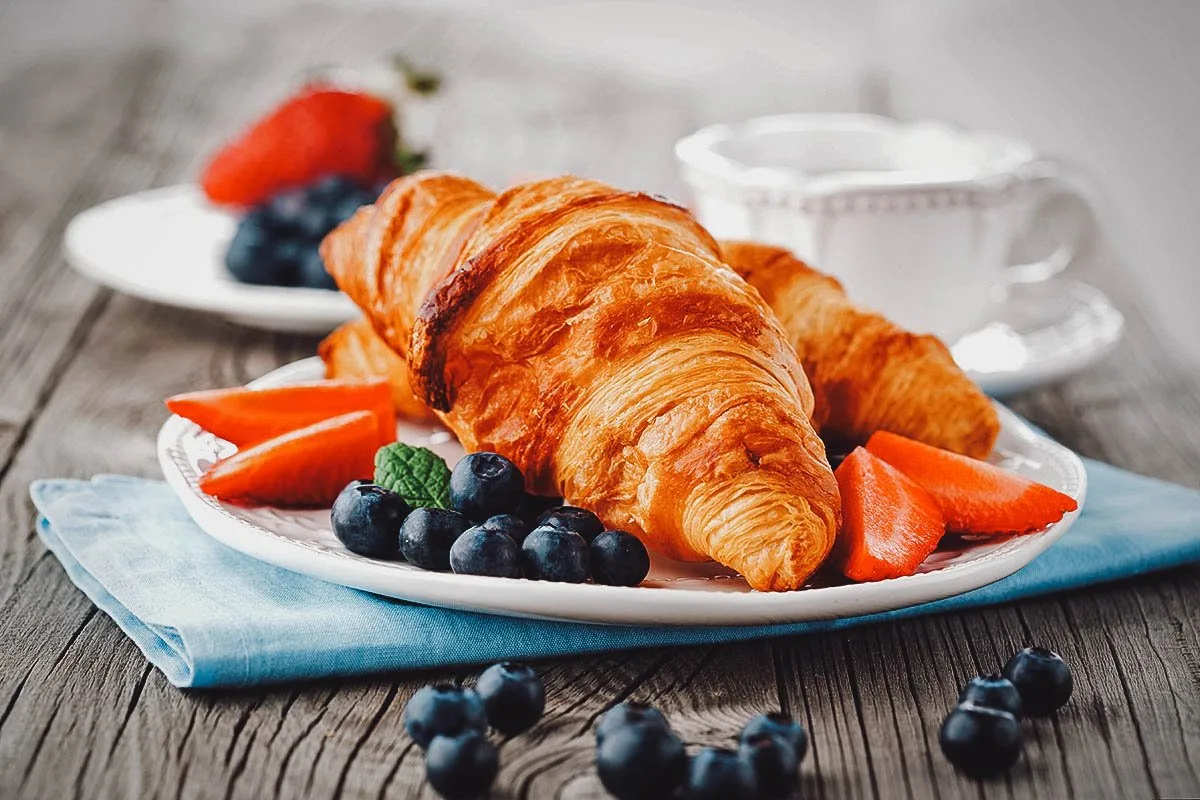
Photo by Iuliia
2. Croquembouche
What’s better than a choux pastry puff? How about dozens of choux pastry puffs piled into a cone and wrapped in thin threads of caramel? That’s exactly what the croquembouche is.
Also known as croque-en-bouche, which means “something that crunches in the mouth”, this tower of deliciousness is a common sight at weddings, banquets, and other gatherings. The choux pastry puffs are typically cream-filled and adorned with other tasty decorations like melted chocolate, sugared almonds, strawberries, and edible flowers.
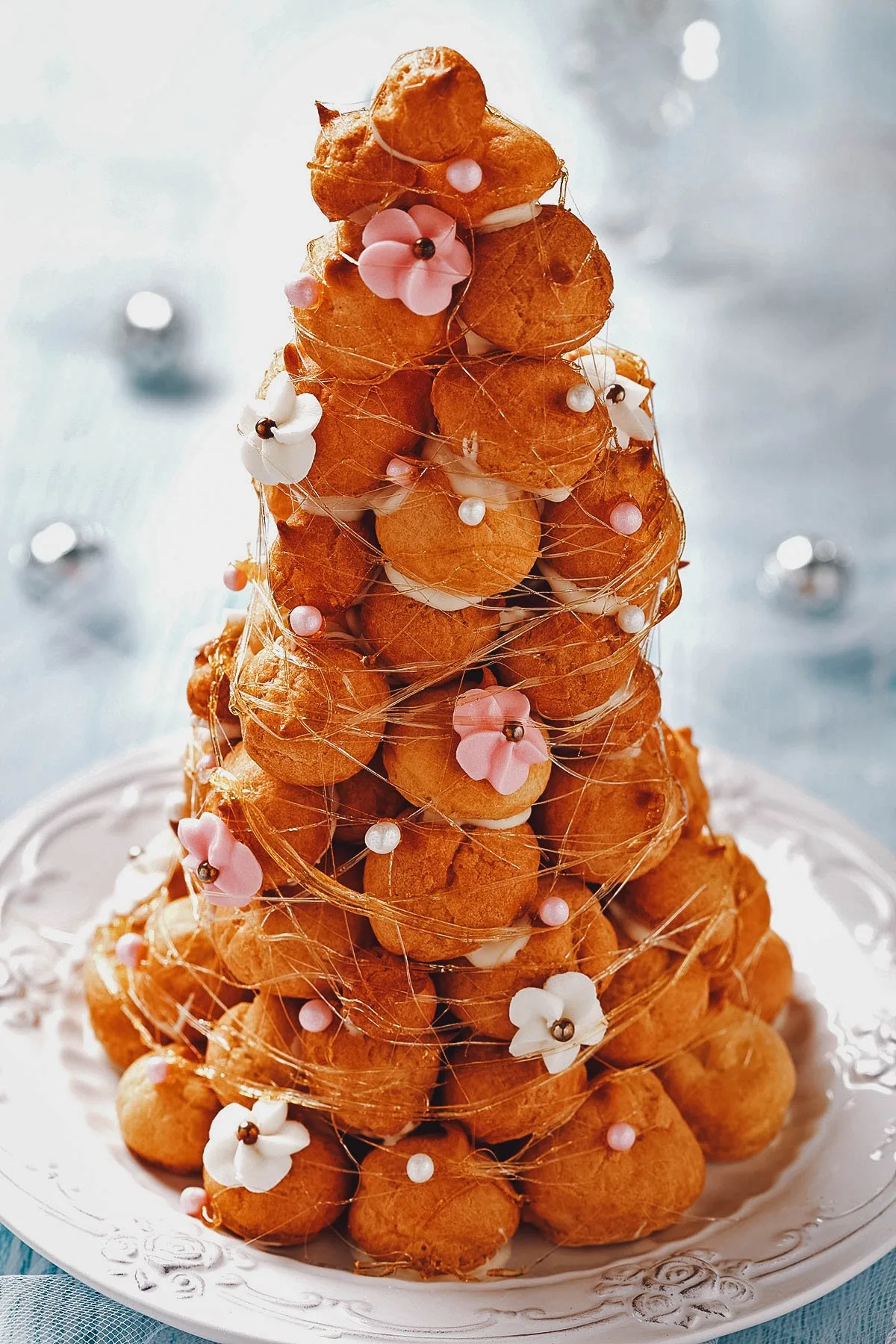
Photo by Odelinde
3. Chouquette
If you like croquembouche, then you’re definitely going to enjoy chouquettes. They’re light and airy choux pastry puffs baked with sucre perlé or pearl sugar, a type of specialty sugar popular in Europe. They’re made by compressing sugar crystals together to form larger nibs that hold their shape and crunch and don’t dissolve into the pastry when baked.
Like croissants, chouquettes are a type of viennoiserie pastry. They’re sold in bakeries throughout France and are traditionally eaten for breakfast or as an afternoon snack.
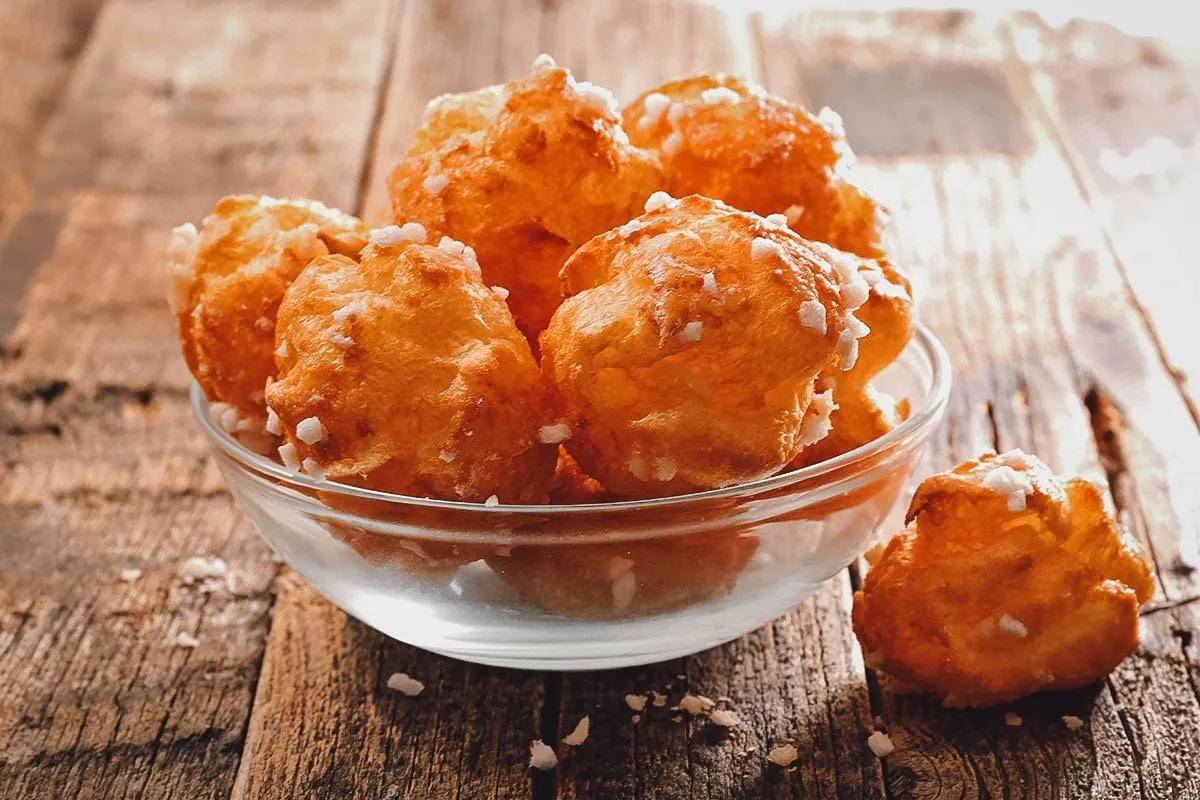
Photo by studioM
4. Financier
A financier is a small, bite-sized French almond cake. Similar in size to petits fours, these small cakes are made with almonds, hazelnut, egg whites, flour, powdered sugar, and beurre noisette (brown butter). They’re typically baked in small rectangular molds and are known for having a light and moist interior with a slightly crispy outer crust.
Financiers were said to have been invented by the Vistadine order of nuns in the 17th century. It’s unclear how these small French cakes got their name, but one story claims that the name “financier” is derived from the rectangular mold that resembles a bar of gold.
Another theory claims that the name is linked to the Paris Stock Exchange. These small cakes became popular in the financial district because they could easily be stored in the pocket for long periods without being damaged.
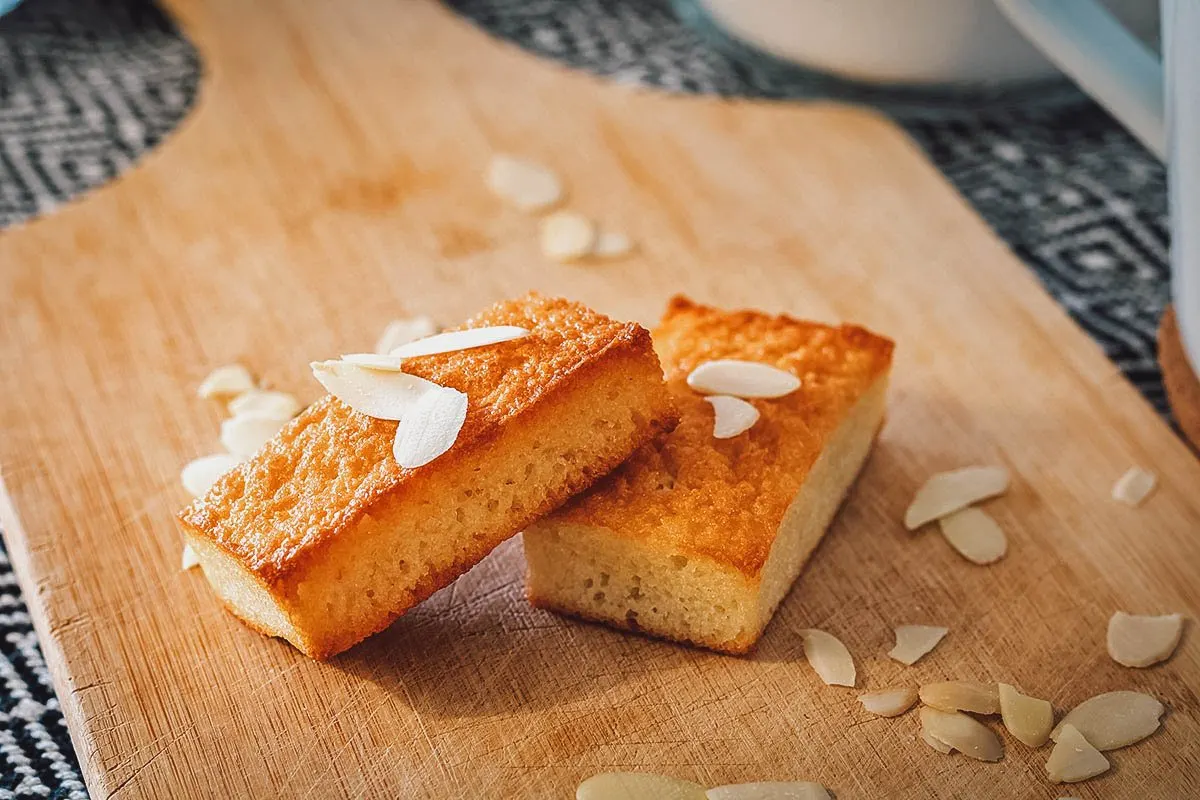
Photo by Ldgfr-Photos
5. Beignets
People from New Orleans are no strangers to these delicious pastries.
Beignets are a type of deep-fried pastry typically made from pâte à choux, though they can be made from other types of dough as well. They’re originally from France and were brought to the Acadia region of Canada by French settlers sometime in the 17th century. Many Acadians later moved to Louisiana, bringing the beignet with them.
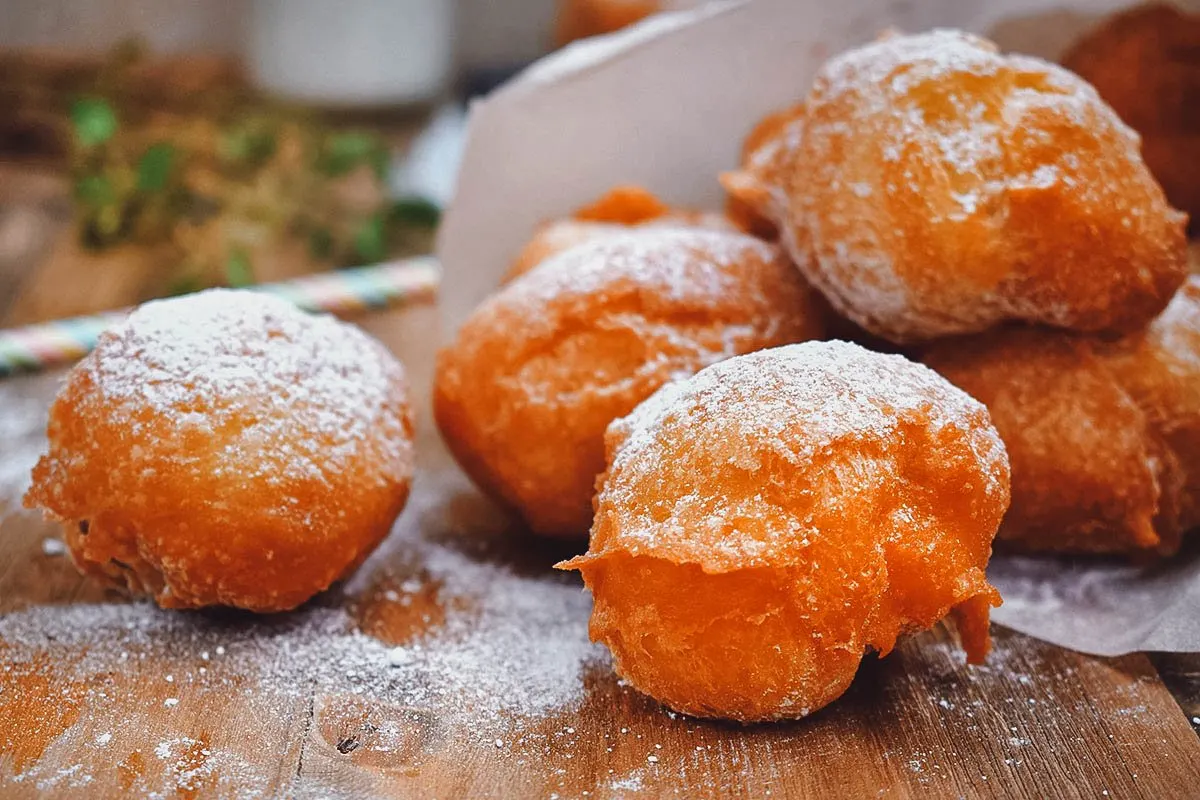
Photo by Kcuxen
In New Orleans, beignets are often made with leavened dough instead of choux pastry. They’re typically shaped into squares and served hot with a generous dusting of powdered sugar. They’re traditionally eaten for breakfast or for dessert, usually with a cup of hot chocolate or café au lait.
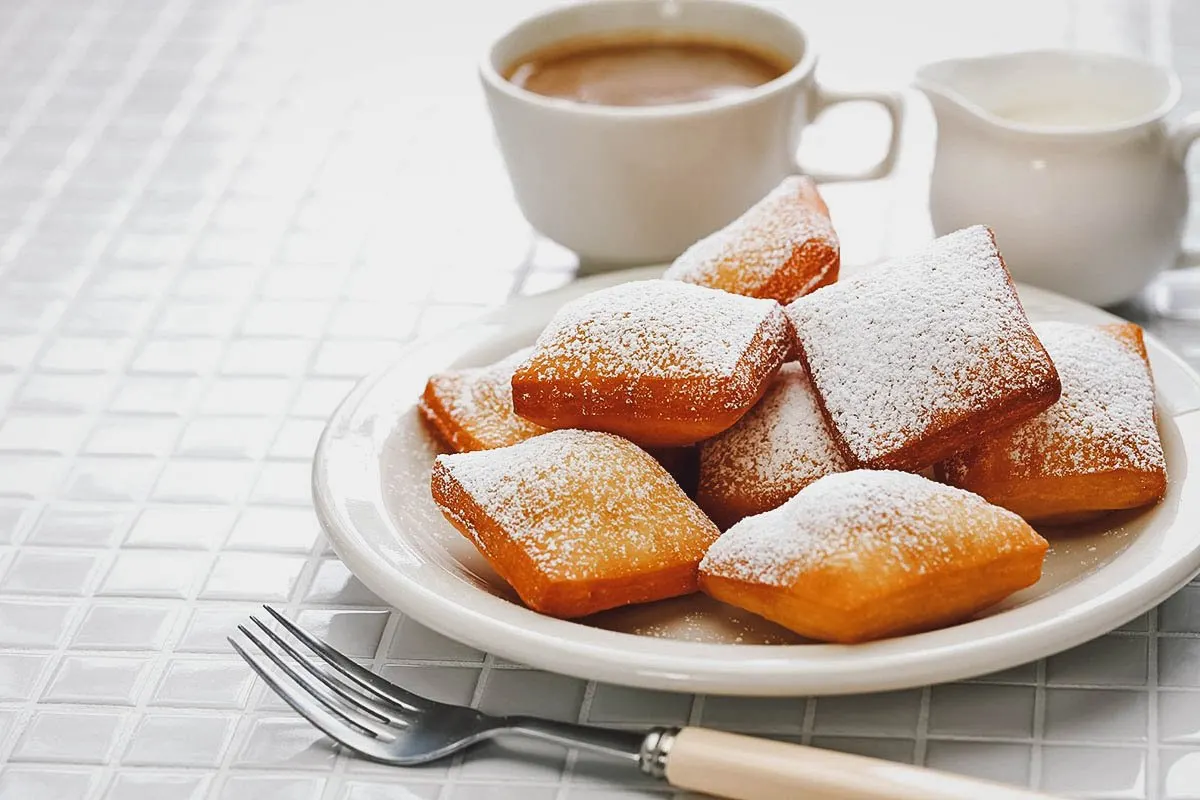
Photo by asimojet
In France, it’s common to find beignets that are round or oval in shape. They’re much more cake-like in texture compared to their airier and crispier American cousins. These yeastier beignets are also referred to as “boules de Berlin” in France because they’re made with a similar dough as the German Berliner doughnut.
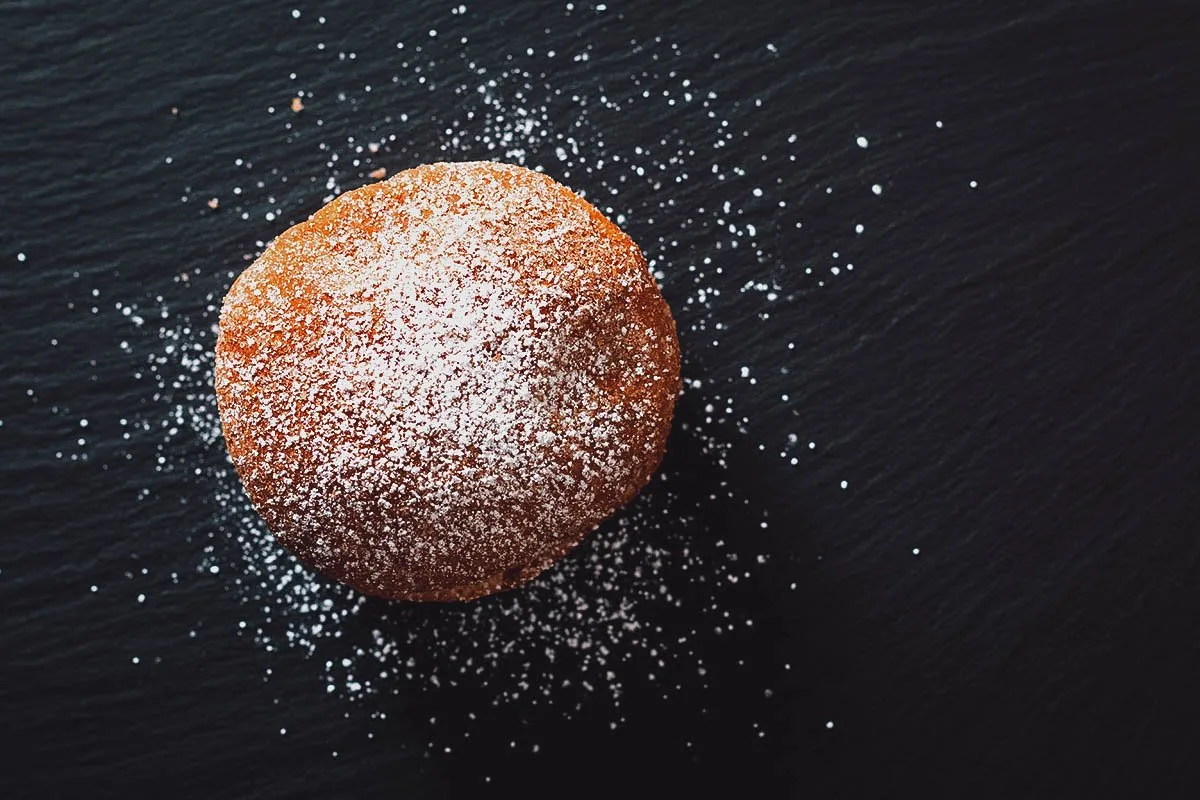
Photo by [email protected]
6. Paris-brest
The Paris-Brest is another dessert that choux pastry lovers will surely enjoy. Shaped like a bicycle wheel, it refers to a pastry made with a ring of pâte à choux split in half and filled with a praline-flavored cream.
The Paris-Brest was invented in the early 20th century to commemorate the Paris-Brest-Paris bicycle race, hence its wheel-like shape. Studded with almonds and dusted with powdered sugar, it was an instant hit with cyclists competing in the race because of its high caloric value. Today, it’s widely available in patisseries throughout France.
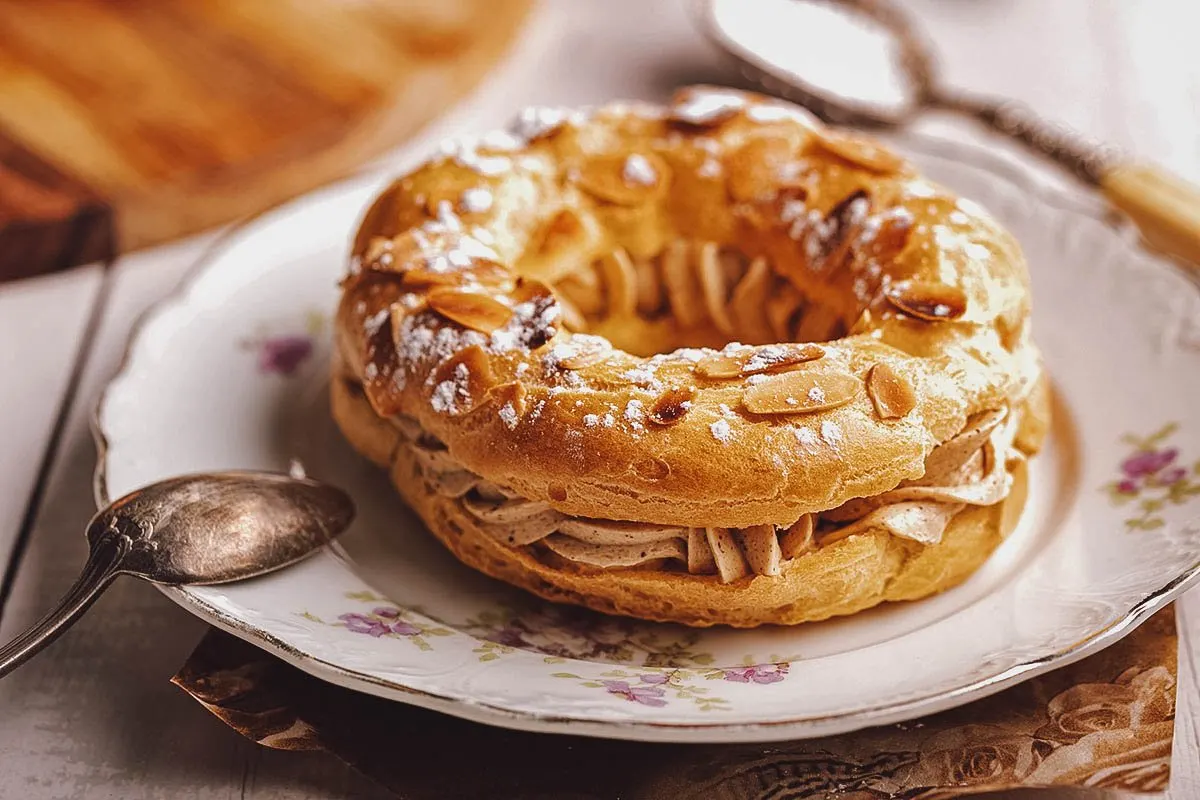
Photo by emmanuellegrimaud
7. Canelé
The canelé is one of our favorite French pastries. Shaped like a striated cork with a dimple on top, it refers to a small, rum- and vanilla-flavored pastry commonly enjoyed for breakfast, dessert, or as a mid-day snack.
These irresistible little desserts are made in small, cylindrical fluted molds brushed with beeswax or butter. The molds were traditionally brushed with beeswax but these days, butter is more commonly used. When freshly baked, they’re soft and custardy on the inside with a dark and crispy caramelized crust.
The canelé is a specialty of the Bordeaux region of France though it’s now widely available throughout the country and beyond.
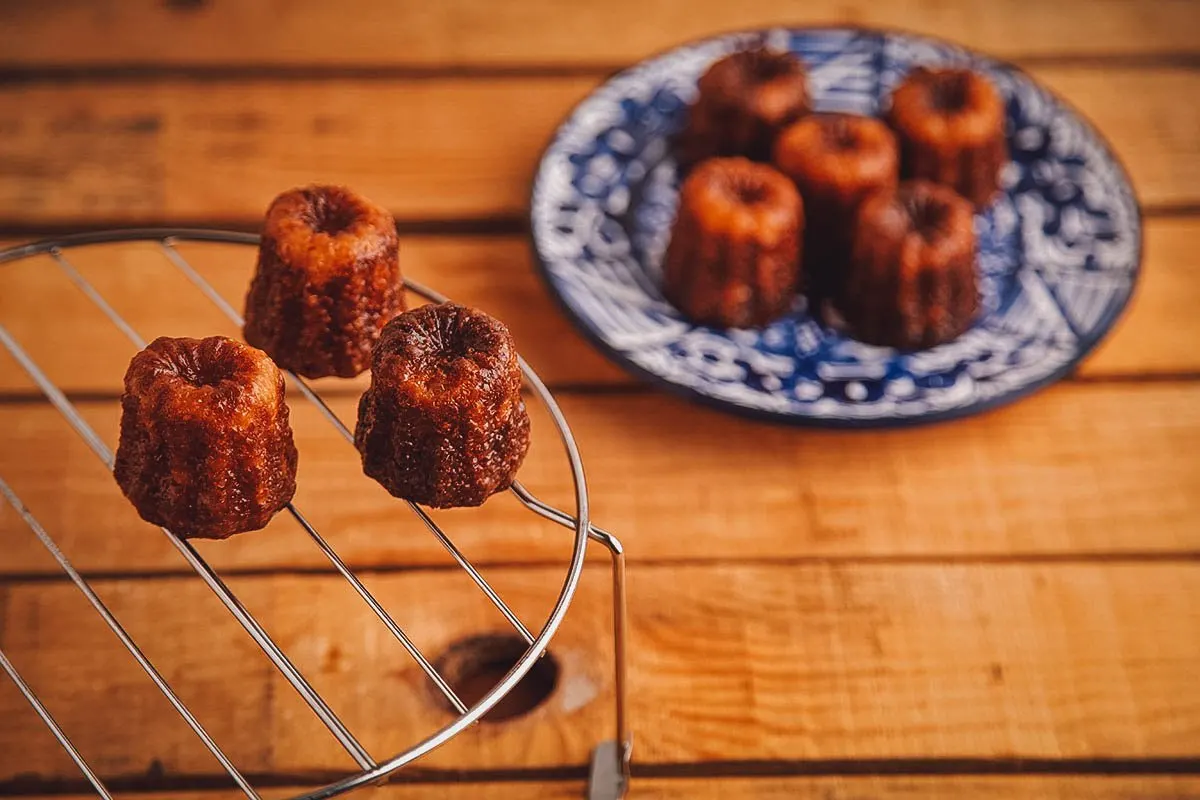
Photo by Robcarfo
8. Pain au Chocolate
Like croissants and chouquettes, the pain au chocolat is another type of viennoiserie pastry. Pain au chocolat literally means “chocolate bread” and refers to a puff-pastry-like dessert made with a yeast-laminated dough filled with a few pieces of dark chocolate or chocolate ganache.
The pain au chocolat is made with the same layered dough as the croissant. Though shaped differently, it’s quite similar in taste and texture so you can think of it as a type of croissant filled with chocolate.
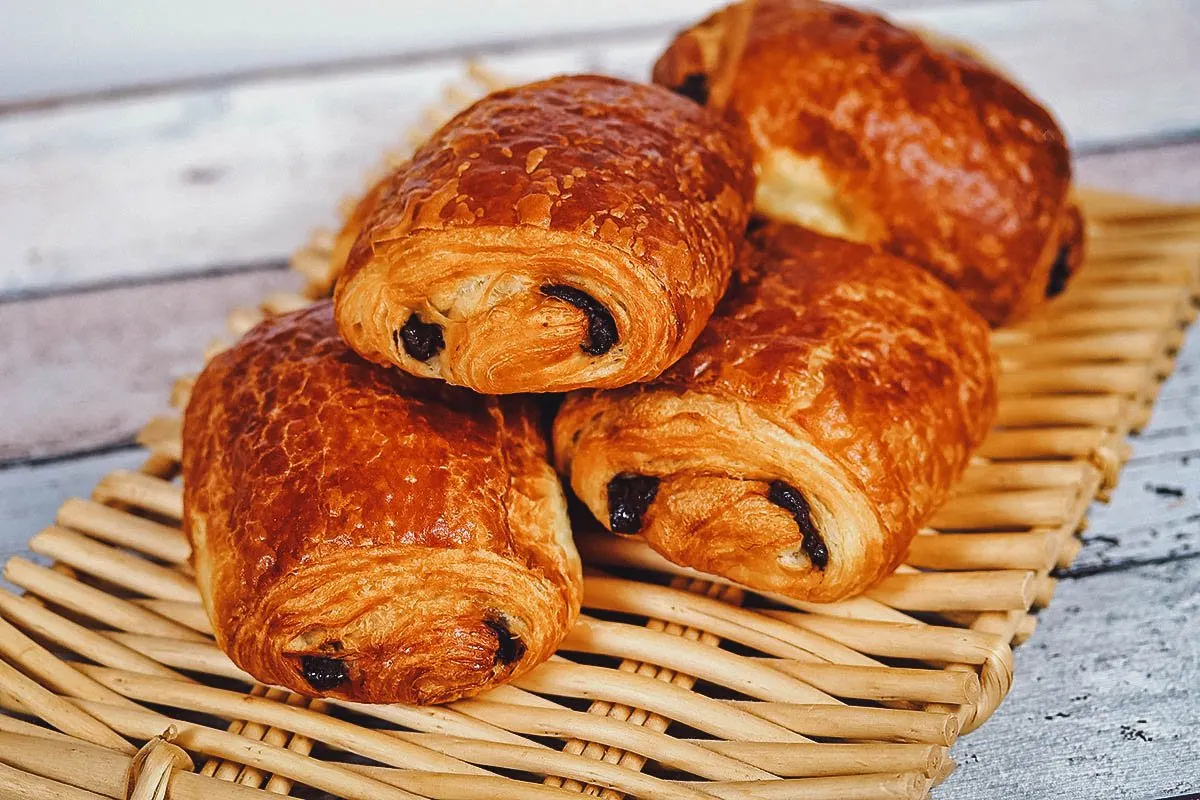
Photo by frederiquewacquier
9. Eclair
Like the croissant, the eclair is among the most popular French pastries. It refers to an oblong-shaped choux pastry filled with pastry cream and topped with chocolate ganache.
The eclair is one of my favorite French pastries but I never knew that its name literally means “flash of lightning”. Apparently, it gets its name from being so delicious that it always gets eaten quickly. I can definitely attest to that!
Classic eclairs are made with vanilla pastry cream and chocolate ganache, but they can also be filled with other types of sweet cream like whipped cream, chiboust cream, fruit-flavored fillings, and chestnut purée. They can be topped with different types of icing and adorned with decorative ingredients as well.
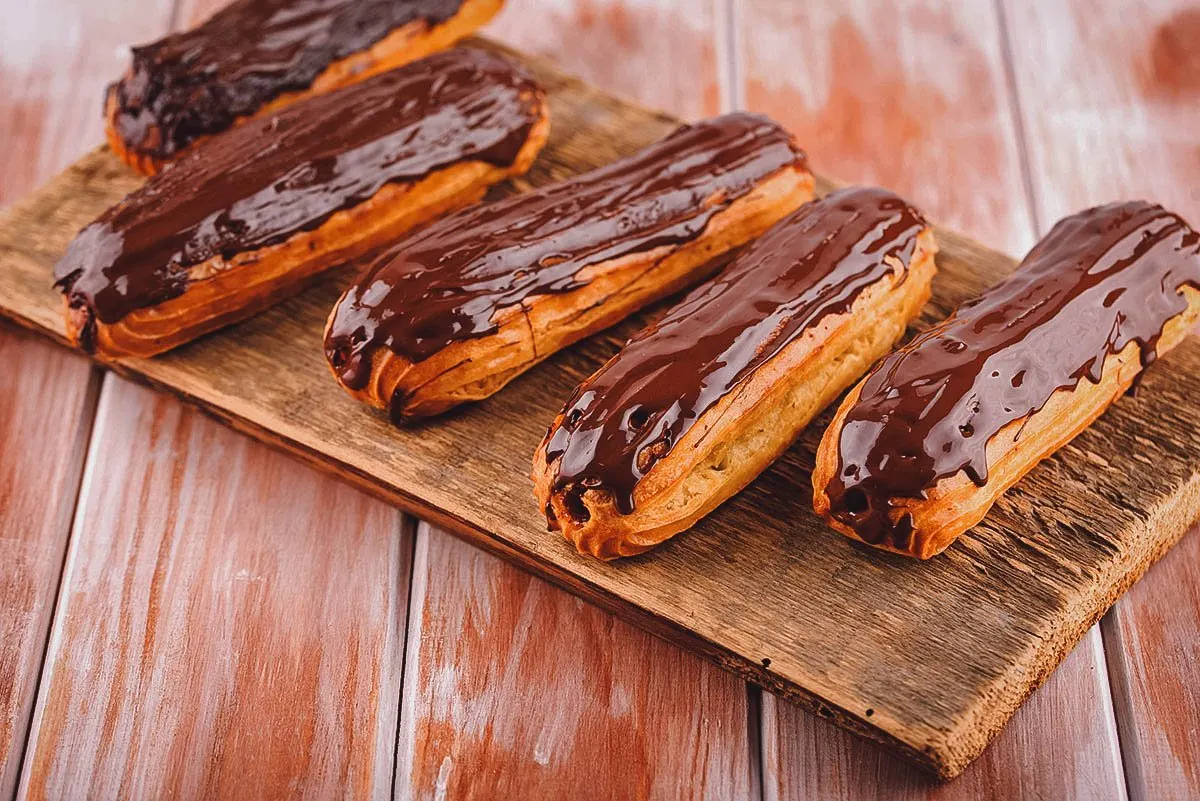
Photo by eugeniashulim.gmail.com
10. Profiterole
As a child, I’d get giddy with excitement whenever my mother would bring home pastry packages from our favorite patisserie. In these packages were eclairs and profiteroles, otherwise known as cream puffs or chou à la crème. I guess that was when I developed my lifelong love affair with choux pastries.
Some people make a distinction between the two but from what I understand, “profiterole” and “cream puff” are interchangeable terms used to describe the same thing – this irresistibly delicious choux pastry filled with a sweet cream like custard, whipped cream, or even vanilla ice cream.
They can be served plain or topped with chocolate ganache, caramel, or powdered sugar. Profiteroles glazed with caramel are typically the versions used to assemble croquembouches.
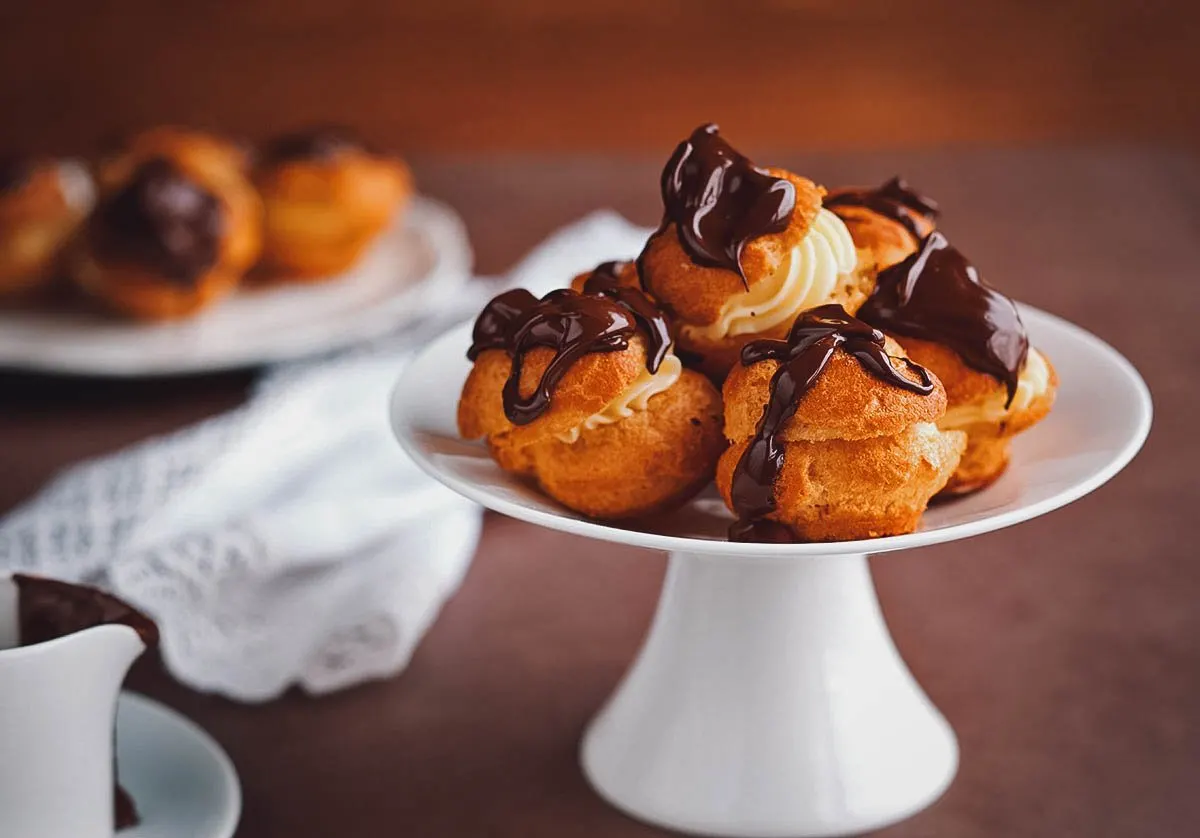
Photo by sarsmis
11. Brioche
I didn’t think brioche counted as a type of pastry but it actually does. It can be classified as both a pastry and a bread thanks to its higher butter and egg content.
Brioche refers to a richer type of bread made with more eggs, butter, and liquids like milk, water, cream, and sometimes brandy. Together with pain au lait and pain aux raisins, it belongs to a leavened subcategory of viennoiserie pastries. It’s a versatile pastry that can be served plain or filled with a variety of sweet and savory ingredients like fruit, jam, chocolate, sausage, and foie gras.
Interestingly, brioche was the pastry mentioned in the famous saying “Qu’ils mangent de la brioche“, commonly translated in English as “Let them eat cake”. It’s often attributed to Marie Antoinette though there’s no evidence to support this.
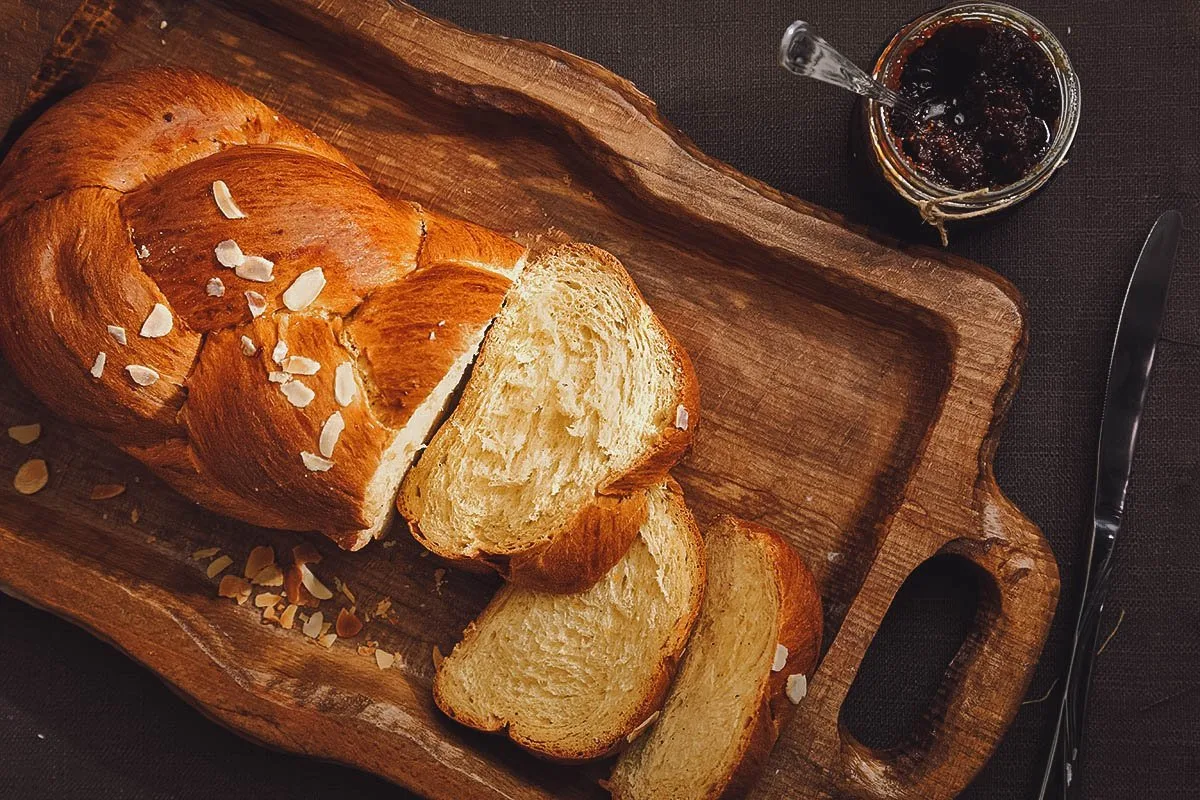
Photo by viperagp
12. Madeleine
The madeleine is a small sponge cake that originated from the communes of Commercy and Liverdun in northeastern France. It’s known for its distinctive shell-like shape derived from baking in a pan with shell-like depressions.
Madeleines are traditionally made with a génoise cake batter and finely ground nuts, usually almonds. They’re similar in flavor to classic sponge cake though perhaps a bit lighter and airier in texture.
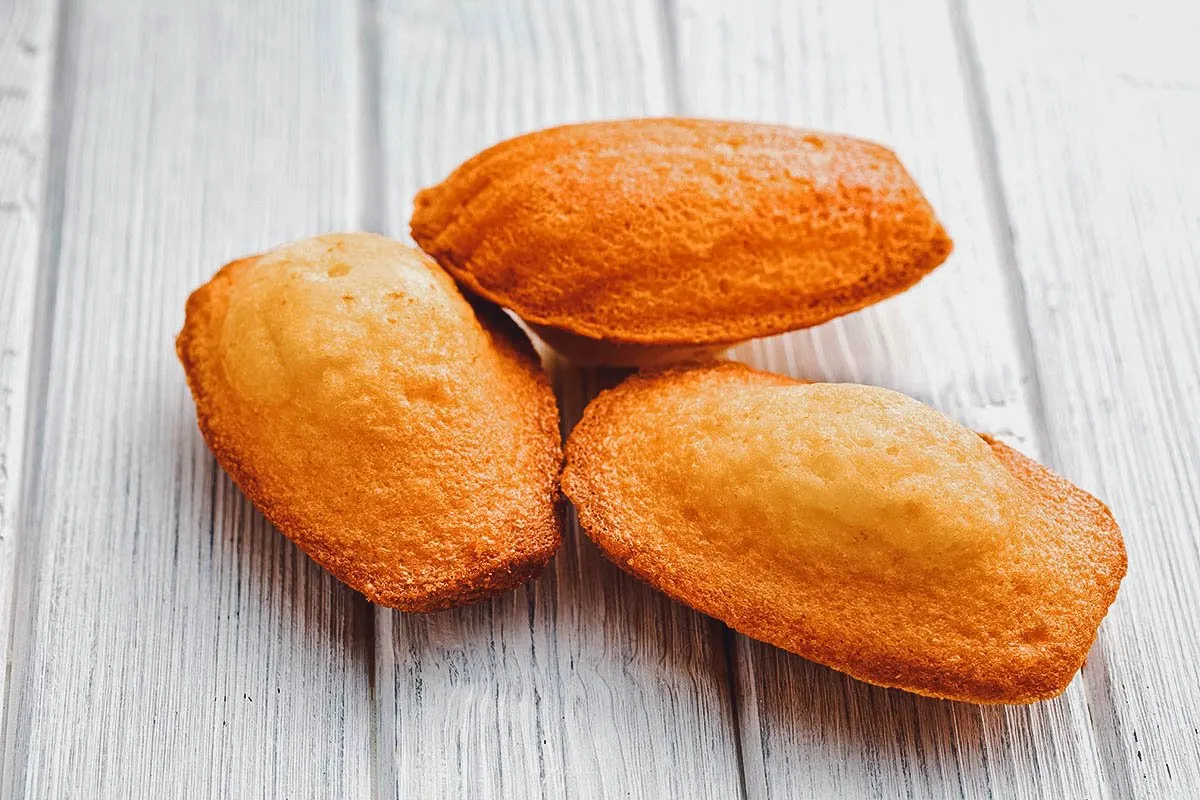
Photo by jirkaejc
13. Macarons
Aside from being one of the most popular, French macarons have to be some of the most fun and visually striking French pastries. Concocted in a multitude of colors and flavors, it refers to a meringue-based cookie sandwich made from egg whites, almond powder, sugar, and food coloring.
Light and delicate on the outside but moist and chewy on the inside, French macarons can be made with a variety of fillings like chocolate ganache, buttercream, or jam piped in between the almond meringue cookies. They aren’t to be confused with the macaroon which is a heavier type of cookie made with sweetened coconut flakes.
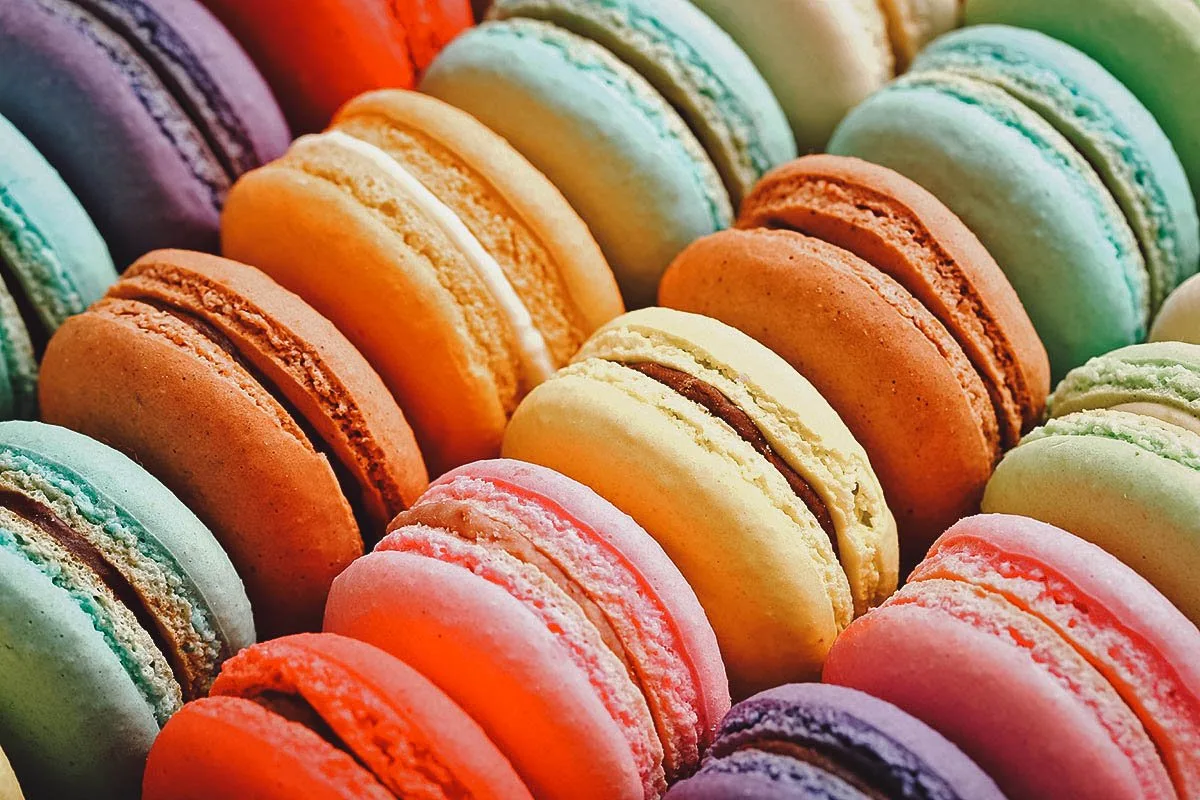
Photo by 5seconds
14. Mille-Feuille
Mille-feuille literally means “thousand sheets” and refers to a layered pastry of French origin. Traditionally, it consists of three layers of flaky puff pastry alternating with two layers of pastry cream, though they can be made with fewer or more layers.
The top layer of mille-feuille is usually coated with a sprinkling of icing sugar or glazed with alternating white (icing) and brown (chocolate) strips which are then combed to create a pattern or design. They can also be layered with other fillings like whipped cream, nut paste, and fresh fruits, most commonly strawberry or raspberry.
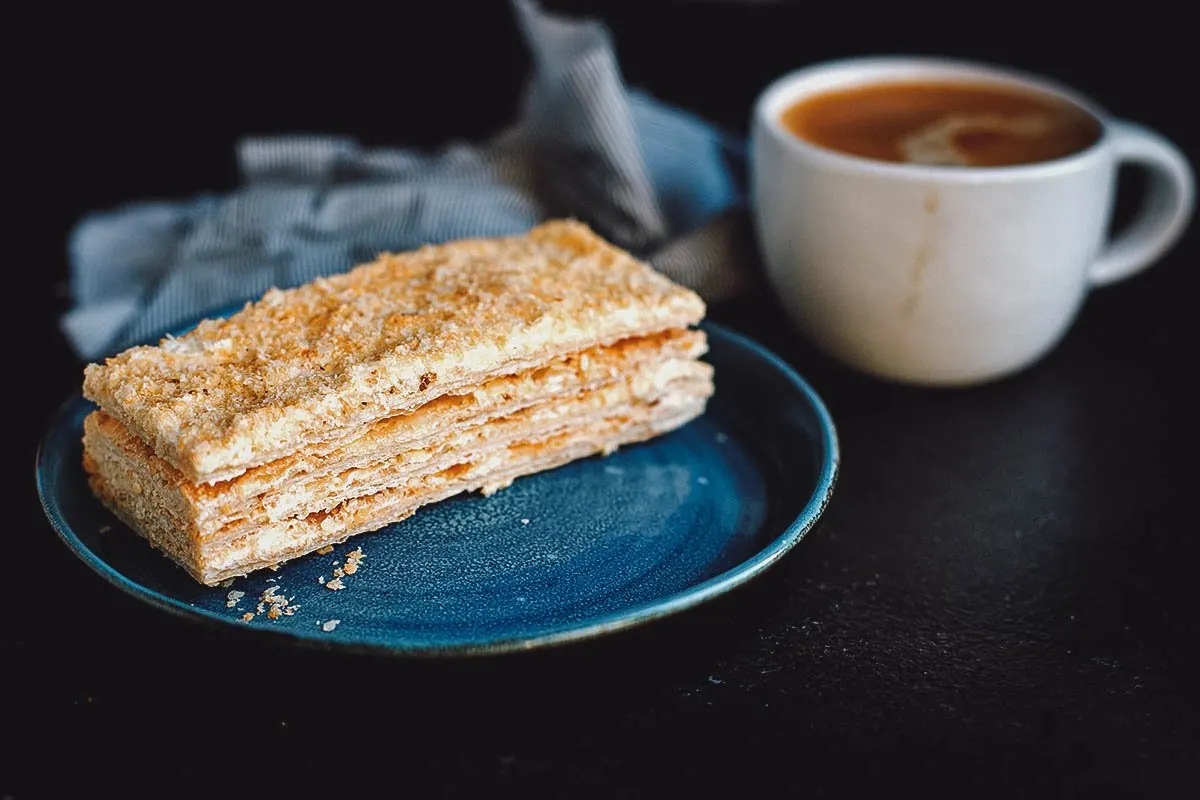
Photo by a-lesa-lesa
15. Palmier
The palmier is a type of French puff pastry made in the shape of a palm leaf. Its name is short for feuille de palmier, meaning “palm tree leaf”. Because of its distinctive shape, it also goes by the names palm heart, pig’s ear, or elephant ear.
Like croissants, palmiers are made with a laminated dough but without yeast. This irresistibly flaky pastry is made with alternating layers of dough and butter which are rolled and folded over repeatedly before being coated in sugar and baked.
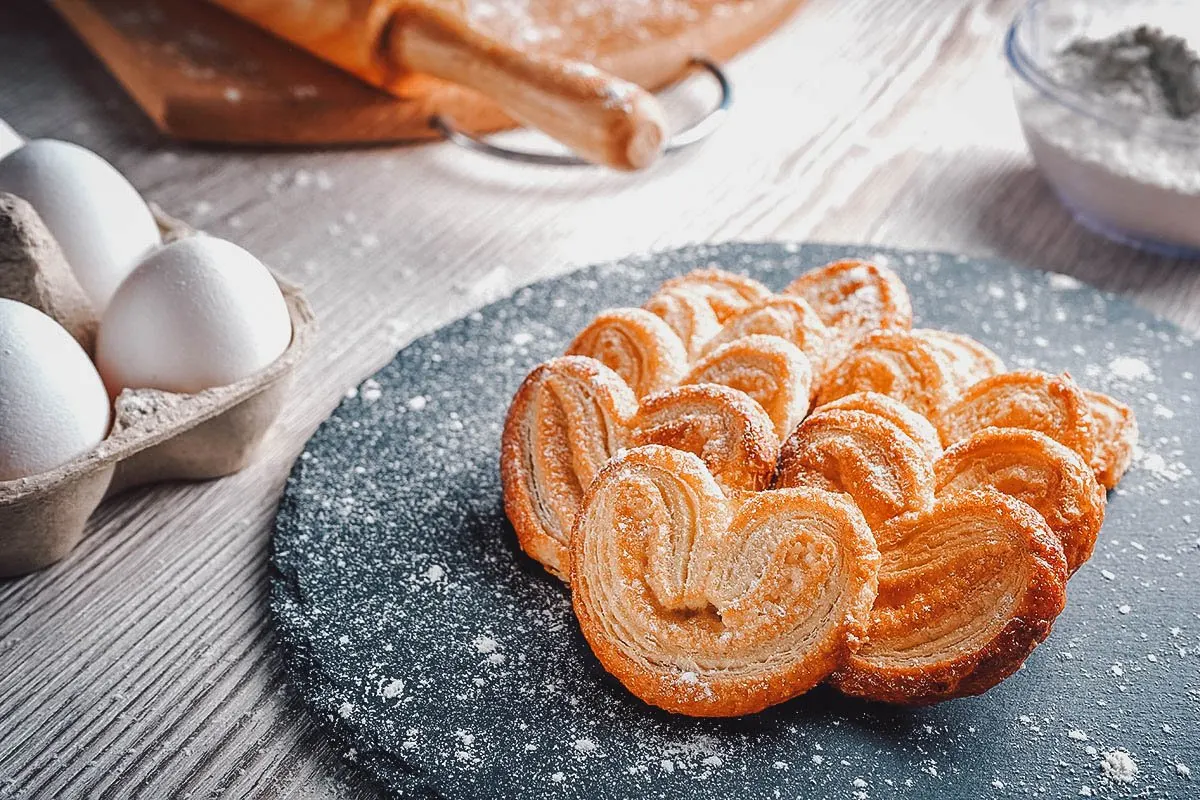
Photo by [email protected]
16. Kouign-Amann
The kouign amann is a multi-layered Breton cake originally from Douarnenez in Finistère, Brittany. Made with laminated dough and a generous helping of sugar, you can think of it as a round caramelized version of the croissant.
Kouign amanns are made in a similar way as croissants but with the addition of sugar sprinkled between the layers of bread dough and butter. As the pastry bakes, the sugar caramelizes while the butter expands the dough, resulting in a sweet pastry with a moist and buttery center and a crispy, caramelized coating.
Kouign amann is delicious enough on its own, but when served warm with a scoop of vanilla ice cream, it’s pure heavenly bliss.
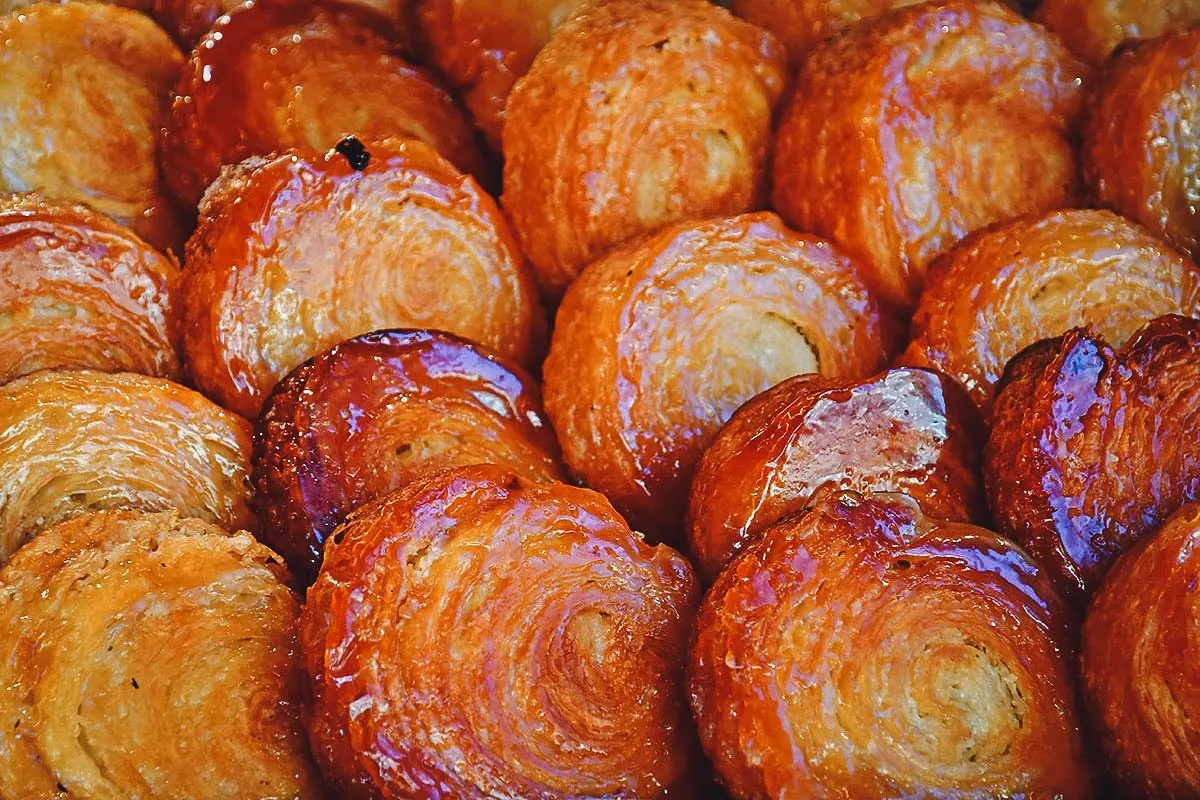
Photo by packshot
17. Opéra Cake
If you like coffee desserts, then this pastry cake flavored with coffee syrup and coffee buttercream is right up your alley.
The opéra cake is a classic French dessert made with layers of almond sponge cake. The sponge cake is soaked in coffee syrup and layered with chocolate ganache and coffee buttercream before being covered in a chocolate glaze. Traditionally, the word “Opera” is written on top of the cake using chocolate glaze.
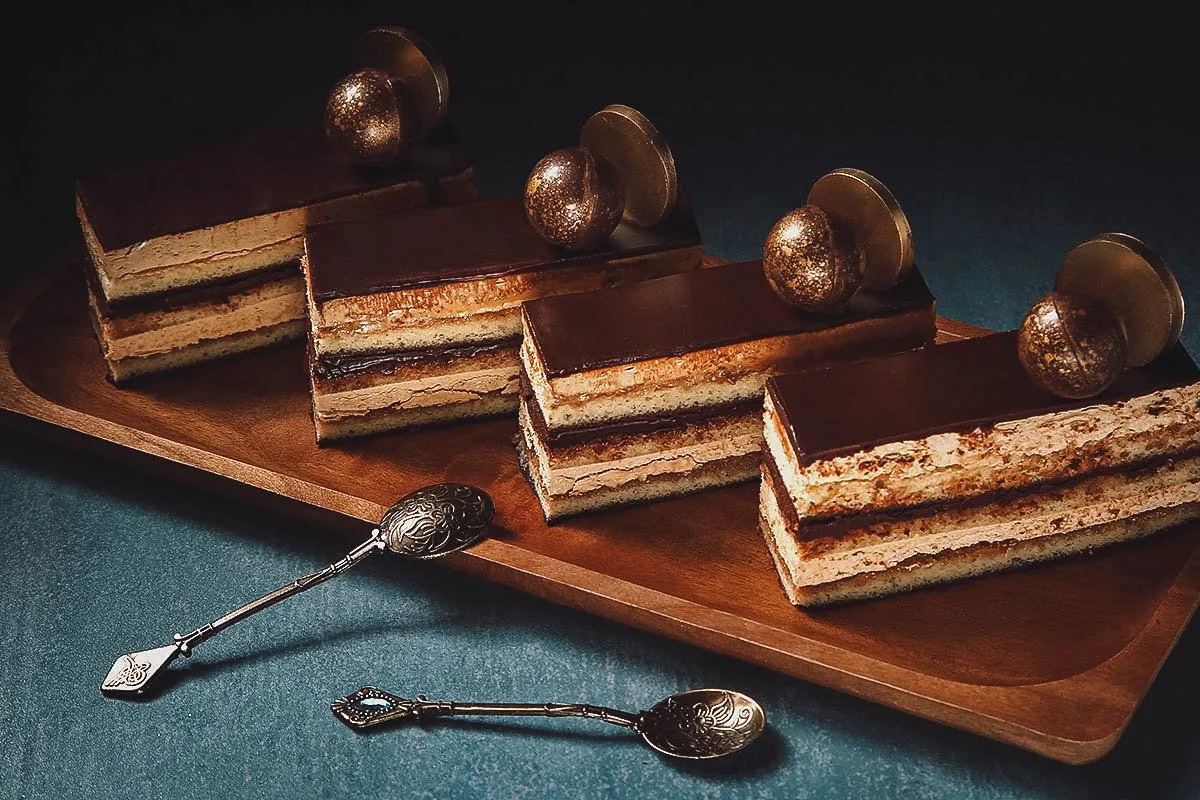
Photo by M-StudioG
18. Religieuse
If you like profiteroles, then you’ll surely find this next pastry to be twice as good. The religieuse consists of two choux pastries – one smaller than the other – held together with elaborately piped buttercream frosting. They’re commonly filled with chocolate or mocha pastry cream and topped with a frosting of the same flavor as the filling.
Religieuse means “religious” or “nun” in French and is meant to represent the papal mitre or ceremonial headdress worn by Christian bishops.
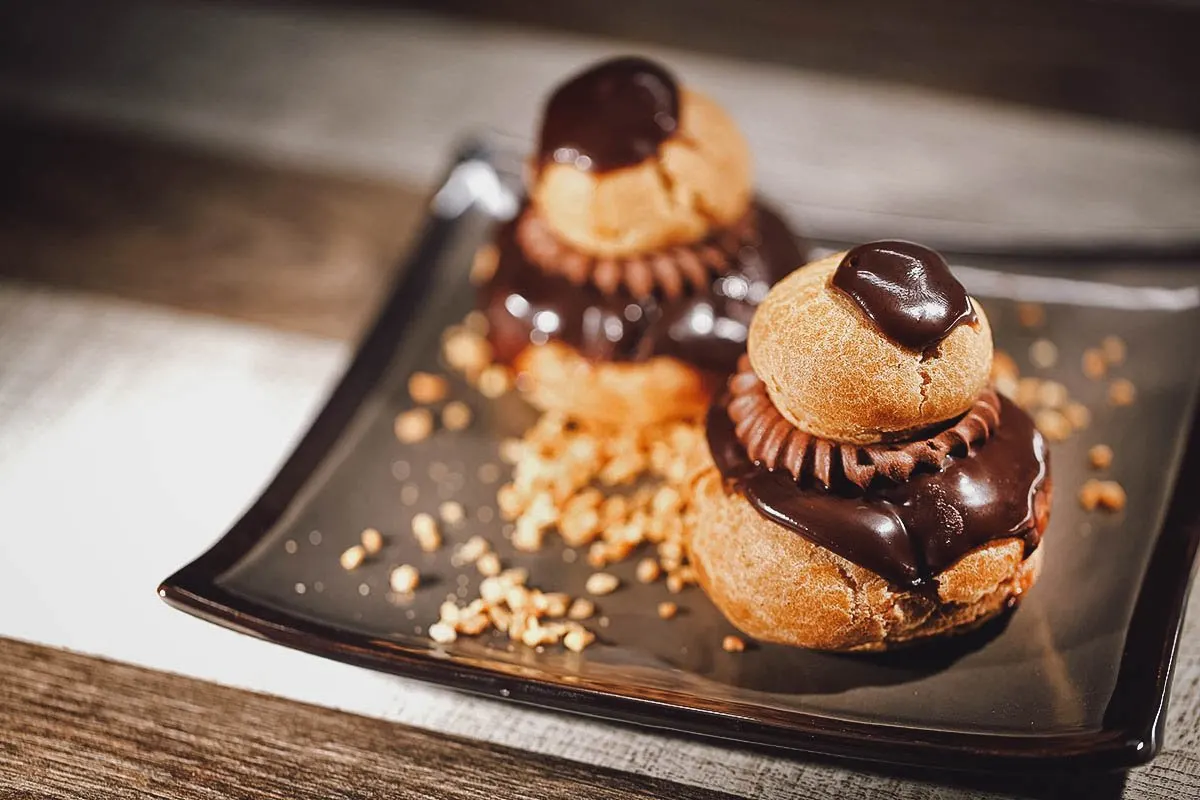
Photo by ruben25
19. St. Honoré Cake
The St. Honoré cake is another dessert made with choux pastry puffs. Named after the French patron saint of bakers and pastry chefs, it consists of a puff pastry base topped with a ring of pâte à choux and small profiteroles dipped in caramelized sugar. The base is traditionally made with chiboust cream and finished with whipped cream piped using a special St. Honoré decorating tip.
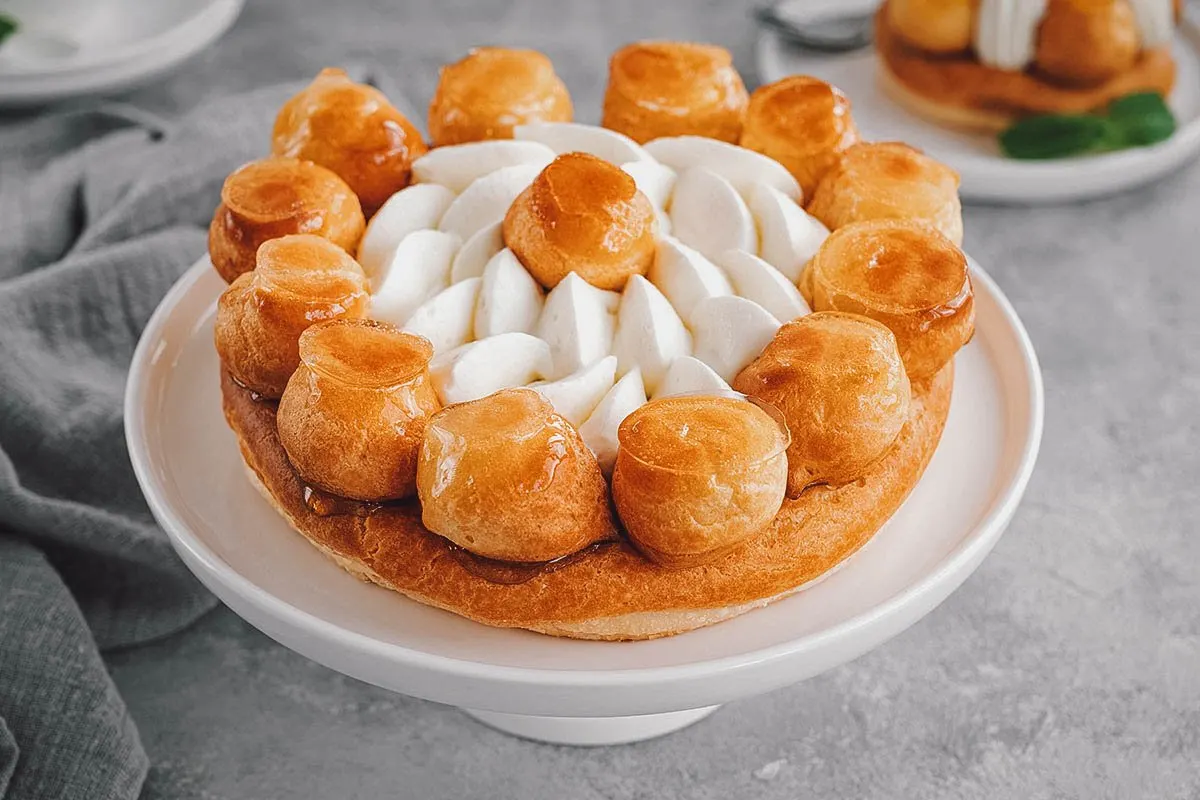
Photo by Irina2511
20. Tarte Tatin
The tarte tatin is an upside-down tart made with fruit caramelized in butter and sugar before being baked. It’s usually made with apples so you can think of it as the French version of apple pie.
This popular fruit tart was named after Stéphanie and Caroline Tatin, two sisters who ran a hotel in the town of Lamotte-Beuvron in the late 19th century. According to the story, they baked an upside down apple tart by mistake. It was too late to bake a new one so they served it to their guests anyway. To their surprise, their guests loved it and it soon became the hotel’s signature dessert.
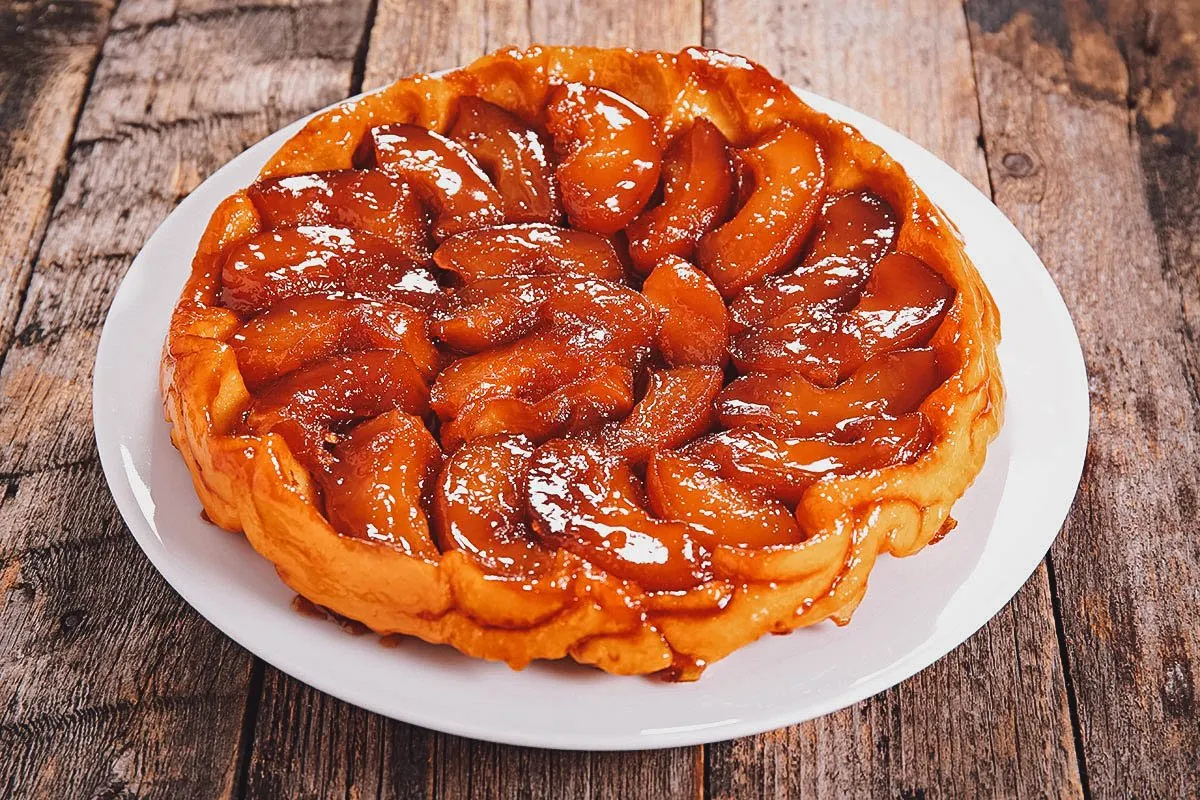
Photo by studioM
FRENCH FOOD TOURS
It’s easy enough to fly to France and stuff your face with as many delicious French pastries as you can, but if you really want to learn about the cuisine, then you may want to go on a food tour. Simply put, no one knows French food better than a local so what better way to learn about the cuisine than by going on a guided tour?
If you’re planning a trip to France, then check out Get Your Guide for a list of food tours in Paris and other destinations throughout the country.
FRENCH COOKING CLASSES
You can learn a lot about the local cuisine by going on a food tour, but if you want to do a deep dive into French food, then one of the best things you can do is to take a cooking class. Eating French pastries and dishes is one thing, but working with the ingredients and learning how to actually make them yourself is another. Check out Cookly for a list of baking and cooking classes in France.
FINAL THOUGHTS ON FRENCH PASTRIES
French pastries are a treasure. Like many people, I enjoy French food but the pastries are my favorite thing about the cuisine. They’re absolutely delicious and something you should experience as much as you can while in France.
We haven’t been back in years but the pastries alone are worth a trip. With magnificent creations like croissants, profiteroles, macarons, and kouign amanns waiting for us, it shouldn’t be long before we find our way back to France. C’est si bon!
Disclosure
Some of the links in this article on French pastries are affiliate links, meaning we’ll earn a small commission if we make a sale at no additional expense to you. As always, we only recommend products and services that we use ourselves and firmly believe in. We really appreciate your support as this helps us make more of these free travel guides. Thank you!
Featured image by Svetlana. Stock images via Depositphotos.


Jean pierre
Tuesday 2nd of August 2022
Love the article on French pastry, although I'm sure it was difficult to write there's so many other pastries available when in France all of which are delicious. The real question is why hasn't pastry taken off in America. You think the American public would like it but other than big cities like New York la Chicago LA you can't find a real pastry shop, yeah you can find folks making cupcakes and donuts but French pastry no wait. My guess is that it has something to do with cost you can't use cheap ingredients or take shortcuts to make French pastry. Jean Pierre
JB & Renée
Tuesday 9th of August 2022
That's a good point Jean Pierre. The cost and difficulty are definitely factors!